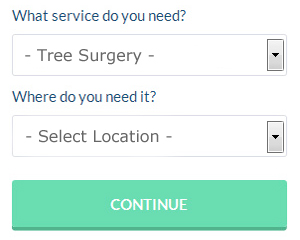Fort William Tree Surgeons (PH33) Scotland: A crucial feature of many gardens and properties in Fort William, trees add style, structure and substance to what can frequently be an unexciting and two dimensional landscape. However, when neglected or affected by extreme weather events like storms or flooding, trees can be a bit of an issue. Seeking the advice and guidance of an established tree surgeon in Fort William, is the safest option when work needs to be completed on your trees.
Those who hire unqualified personnel, or attempt to do tree work for themselves, may cause a risk of damage to the trees, to property or to life. However, even for professional tree surgeons who know about all the risks, tree work is not entirely safe. On average there are 3 deaths and 140 severe injuries each year within the profession, making it one of the most dangerous jobs in Britain and definitely not for novices to attempt.
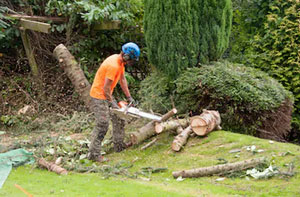
With falling trees or branches causing around five fatalities each year in the United Kingdom, a danger to life can even be presented by a damaged or poorly maintained tree. If you employ someone to do tree work and there is an injury, or damage to property, you could be liable for any compensation to a third-party. These are just some of the reasons why it is essential to use a trained tree surgeon to do the work on your trees. (The source of the above figures was HSE).
A qualified tree surgeon in Fort William ought to be a registered member of one or both of the two professional industry bodies found in the United Kingdom. You can check up on the membership and professional status of any tree surgeon on the websites of either the ISA (International Society of Arboriculture) or the AA (Arboricultural Association). On this webpage you can check membership of either of these 2 associations, which gives the tree surgeon in question, ARB Approved Contractor status.
You will be able to contact these trade bodies for mediation and for help and advice, if there is a problem at any point during the course of the tree work, or after it has been completed.
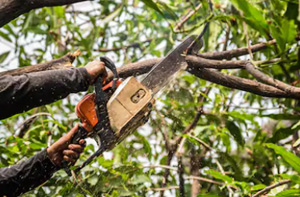
If somebody offers you a quote for any tree work and they're not on this directory, you should courteously decline their offer and continue your search for an approved contractor. Once their qualifications and professional associations have been carefully checked, you should try and get at least 3 price quotes from different companies in and around Fort William. Because of the risks of the work involved, you should ask the following questions, making it abundantly clear that you need to know the answers:
- How much insurance cover is provided? As stipulated by the ISA and AA, your tree surgeon ought to be able to produce an insurance certificate covering a minimum of £5 Million public liability.
- Do you have documentary verification of your professional membership, qualifications and a NPTC certificate for chainsaw use and maintenance? The NPTC/LANTRA certificate is required by law for any tree worker who uses a chainsaw. Qualifications might include Certificates and National Diplomas in Arboriculture.
- Can I assess the quality of your tree work by contacting a person you've worked for recently? Doing an independent examination of any recent work is always a good idea.
- Can you provide a quotation in writing? Verbal quotes alone aren't acceptable. Always try to get a quote in writing.
The written quotation that you're provided with must include clear and accurate specifics of the planned tree work. It should state whose responsibility it is to remove debris, tree branches and stumps, and should also include details of any trees which may be protected, and the steps necessary to get permission to carry out work on them. You should also make certain VAT has been included on the quotation. You have a responsibility to employ only qualified tradespeople to work on your property and trees, and it is very important to understand that. This is laid out by the "Common law duty of care responsibilities and sometimes liabilities under the Occupier's Liability Acts of 1957 and 1984."
PRIOR TO WORK BEGINNING - Your chosen Fort William tree surgeon will need to make enquiries into the possibility of any trees being protected in your area and make the appropriate steps to ensure that any work can be given the go-ahead from the local authorities. To ensure the safety of the public, even protected trees need to be maintained so as to cut back old or dying wood, therefore discovering that a tree is protected does not mean that you're unable to carry out essential work.
If your property in Fort William is inside a designated conservation area, the Local Planning Authority (LPA) will need at least six weeks written notice of any proposed tree work. This only applies to trees with a trunk diameter of more than 75mm in diameter, at a point 1.5 metres from ground level. If the pruning or thinning of a protected tree's branches are required to promote and sustain growth, written notice is also not necessary.
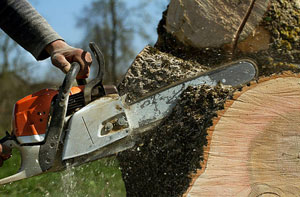
Your Fort William tree surgeon will decide on the remedial treatment needed and how best to achieve the required outcome in a safe manner after performing a complete assessment of your trees health. This involves doing a risk assessment to include public areas, your property and any sections of a neighbour's property that could be affected by falling debris and branches. This stage will also establish the amount of operatives needed and the level of protection required. To keep property and the general public safe from damage or harm, this will include both PPE (personal protective equipment) and other safety measures.
ON THE DAY OF WORK - Barriers and safety measures should be put in place before any tree felling, cutting of branches or climbing begins, to keep unauthorised persons and passers-by away from the area where work is going on. If there's any threat of debris falling into a public road, passing traffic may have to be temporarily halted.
The tree surgeon will need different levels of protection based on the type of work being performed. As the bare minimum when doing chainsaw work they're going to be wearing protective clothing to prevent cutting injuries to the torso, hands and legs. All operatives involved in the work should be wearing high visibility clothing, and head and eye protection, at all times.
Additional workers will normally be needed to help with the removal of high branches and pieces of tree trunk, especially if working at height is involved, and where safety climbing equipment and ladders are being used. For the removal of waste, unhindered access to the work site will be necessary. So, it's advisable to inform your neighbours, as a skip or other transportation vehicle will need to be stationed as close as possible to the workplace whilst the work progresses.
AFTER COMPLETION OF WORK - When the work has been concluded all of the branches and waste can be hauled away and the site cleared of all debris. Your tree surgeon should then prepare and sign off a certificate of work, a copy of which will be given to you. This is especially important where protected trees are involved. If any safety measures were put in public areas they can now be taken away, with footpaths and highways being re-opened to the public.
Problems or issues should be put right immediately by approaching your tree surgeon directly. If any further arbitration is needed, and your tree surgeon is a member of a professional trade body, you can obtain help and advice from the AA or the ISA in order to reach a satisfactory solution.
Local Fort William tree surgery services will most likely have the postcode PH33 and the telephone dialling code 01397. They'll operate in Fort William itself, along with nearby areas such as Glencoe, Caol, Killin, Inverlochy, Kinlochleven, Banavie, Onich, Mallaig, Lochyside, Torlundy, Druimarbin, Fort Augustus, Spean Bridge, Corpach, and these postcodes: PH33 6EA, PH33 6QL, PH33 6LH, PH33 6JS, PH33 6QH, PH33 6LP, PH33 6EE, PH33 6BJ, PH33 6DP, PH33 6QJ. Checking this out can confirm you are accessing a local tree surgeon. Fort William property owners will be able to utilise these and countless other related services.
For this kind of assistance it's definitely advisable to use a competent local tree surgeon. Fort William property owners can benefit from the knowledge and skills that a seasoned professional can offer.
Tree Surgery - Safety Considerations

The safety aspect is one of the principal worries when you are having tree surgery done, as if carried out incorrectly it can definitely be a very dangerous undertaking. If the individuals doing the work are inexperienced or untrained, there are a number of factors that can easily go awry such as hardly any protection from falling, in the shape of ropes, harnesses and platforms, neglecting to cordon-off the area to safeguard the general public and vehicles, not using eyesight or hearing protection, falling branches and timber, an absence of head protection and failure to put on cut resistant clothing (specifically boots and trousers). What might be at risk because of such inadequacies are vehicles, the street facilities, the home owners, garden outbuildings and fences, passers by, the groundsperson, nearby properties, the tree surgeon himself (up the tree), the actual tree.
Removal of Tree Stumps Fort William
If you're in a position where you need to have a large tree removed from your property in Fort William, you're possibly going to be stuck with a stump, which will also have to be tackled. You might consider leaving it to decay and rot away in a natural way, and be perfectly happy to leave it to its own devices. However, a big stump could take several years to rot down, and may even send out suckers in an effort to restore itself to its former glory. Protruding tree stumps can also be a trip hazard, an eysore and can attract unwelcome pests.
If you choose to remove the tree stump completely, there are several ways you can accomplish this, however they basically fall under two main alternatives stump grinding or stump removal. In the next couple of paragraphs we'll be focusing on the removal alternative as opposed to grinding.
There are basically three main procedures that you can use to remove a tree stump - you can use a chemical stump killer, you can burn it or you can dig it out by hand. If your intention is to carry out the tree stump removal yourself, any one of these strategies could be an option. Tree surgeons themselves will typically go with the previously mentioned stump grinding option, although may offer the alternative of a chemical treatment such as eco-plugging.
Tree Stump Removal by Burning: Because it may conflict with local laws and can definitely be quite dangerous, burning stumps isn't a recommended course of action. If you decide upon this technique, great care must be taken. A few 1" holes will need to be drilled in the tree stump, and over a period of several days continually topped up with vegetable oil. You should then cover the tree stump with logs or charcoal and set fire to it. Someone will need to supervise this constantly until the fire has died down. When the fire has burnt out, you must ensure that it's extinguished and cooled off, after which you can dig out the stump debris and roots.
This isn't the only way to burn a stump, and you could also try scooping out all the soil from beneath the stump and lighting a fire in the void that's been created underneath. You should never set light to a tree stump if it is near to fences, a building or other trees.
Chemical Stump Removal: For chemically removing a tree stump you'll need to purchase Roundup Tree Stump Remover, Vitax SBK Stump Killer or Resolva Xtra Tough Tree Stump Killer. Wear gloves and avoid contact with the skin when applying any of these chemical solutions, and also avoid inhaling. You must abide by the manufacturer's instructions, for timings, applications and quantities. Depending on the dimensions of your tree stump, and whether it's alive or dead at the time of treatment, it can take quite a few weeks or perhaps even months for a stump to break down completely, so consider this to be as a long term rather than a short term fix. Once well decayed, it can be chopped small with an axe and dug out with a shovel.
Stump Digging: Digging out a tree stump by hand is a relatively straightforward procedure, and involves shoveling out out all the soil all around the stump, exposing and sawing all the primary roots, and eventually freeing the stump so that it can be lifted out. For the final freeing process you might need to use some form of winch. This is extremely hard work and not for the faint-hearted or unfit.
(Tags: Tree Stump Removal Fort William, Removing Tree Stumps Fort William, Removal of Tree Stumps Fort William, Chemical Stump Killers Fort William).Pollarding Trees Fort William
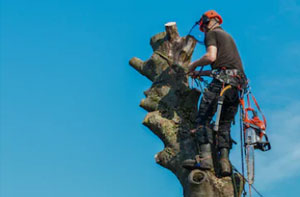
Pollarding is principally carried out for basic safety reasons and is a procedure for greatly reducing the size of trees which have grown too big for their current environment. This tactic is also occasionally used for visual reasons to change a tree into a particularly appealing form or shape. It is sometimes witnessed on trees that function as boundaries or hedgerows, and also trees which grow beside streets in Fort William. The somewhat stark and naked appearance that is the outcome of pollarding is not at all popular with those who adore trees, because it's so dissimilar to its natural state. The beneficial element of pollarding, is that trees which might otherwise need to be removed can be saved. Pollarding is typically used on broad-leafed tree species like sycamores, planes, limes, oaks, beeches, maples and horse chestnuts. (Tags: Pollarding Fort William, Tree Pruning Fort William, Tree Pollarding Fort William)
Ash Dieback
First recorded in the UK in 2021, ash dieback is a dangerous fungal disease which is expected to decimate about 80 percent of the current ash trees, over the next few years. Set to have huge ramifications for our beloved countryside, ash dieback is probably going to be just as damaging as the previous epidemic of Dutch Elm Disease (DED).
A highly destructive disease of trees of the Fraxinus genus, ash dieback has a particularly disastrous effect on the Fraxinus excelsior (common ash), British Fraxinus excelsior (common or European ash). Originating in Asia, the fungus which causes the disease is called Hymenoscyphus fraxineus (H. fraxineus).
Dispersed by wind blown spores released from the fruiting bodies of the fungus, and are able to travel for tens of miles, ash dieback (or chalara ash dieback) has now spread to most areas of the United Kingdom.
Ash dieback is recognisable by the following symptoms:
- New growth appears from previously dormant buds (epicormic growth).
- Leaves with dark patches that appear during the summertime.
- Dark brown necrotic lesions (often diamond shaped) form where limbs connect to trunk, and the inner bark under the lesions looks brownish grey.
- Foliage that wilts, turns black and falls prematurely.
- Dying leaves and shoots are visible in summer.
To a certain extent, ash trees can fight the infection, however they ultimately succumb as they're continually attacked year-on-year. Presently there's no obvious approach for stopping the spread of achalara ash dieback, and there's no effective treatment.
If you think a tree in your local community is suffering from ash dieback, or you are nervous about a tree on your property in Fort William, you should bring in a local tree surgeon to confirm the diagnosis, and you can also report it to the "Tree Alert Service" provided by the Forestry Commission, although they are now only interested to know about cases in areas that were previously unaffected.
(Tags: Symptoms of Ash Dieback, Chalara Ash Dieback Fort William, Spotting Ash Dieback).Protecting Shrubs and Trees in the Wintertime
Although you might not believe that the weather in the UK is harsh enough to warrant protecting your trees and shrubs, it may be a good idea to take a second look at this. Even the hardiest of plants, shrubs and trees can find it hard during the winter months, and a little bit of additional protection in times of intense cold will unquestionably be a benefit.
When you have trees on your property in Fort William, it's strong winds that are the biggest concern, and they might still be susceptible even though most of them will already have shed their leaves when winter arrives, thus being less wind resistant. If you're worried about the condition of a tree, or it looks like it might topple over, you should contact a local tree surgeon to examine it and conduct a risk assessment. Trees and tree branches can also suffer damage due to heavy snow, so stay alert for damage in this kind of weather. Protection from frost and ice may be needed for some shrubs and trees (particularly recently planted ones), and a deep layer of mulch around their bases will help to keep their roots from freezing, and enable them to continue absorbing moisture.
Chainsaws in Tree Surgery

Probably the most commonplace tool used by Fort William tree surgeons, the chainsaw is also the most dangerous in the wrong hands. Petrol chainsaws are the most preferred by tree care professionals, thanks to their ease of use and greater portability, although corded electric versions are available, and battery operated chainsaws are growing more popular. Where thick branches and large trunks are involved, such substantial tree work calls for the use of the most robust and powerful petrol chainsaws.
Comprising a rotating chain armed with a set of sharp teeth that is driven by a motor and cuts through the bark and branches, a chainsaw is essentially a rather simple tool. Chainsaws also come in different types, each having its own particular use - rear-handled for work at ground level (must always be used with two hands), top-handled for working at height (and which can be operated with one hand) and pole saws for hard to reach branches and long distance pruning.
Despite the fact that carrying a rapidly twirling blade whilst precariously balancing up a tree is not the safest job on the planet, it is pretty rare to find a tree surgeon in Fort William who doesn't use a chainsaw in their day-to-day activities. In order to gain membership of the Arboricultural Association, being trained in the safe use of chainsaws is one of the key prerequisites.
The most popular manufacturers of chainsaw used in the UK by tree care professionals are Makita, Stihl, Husqvarna and Hyundai, although there are quite a few different brands and models.
Tree Surveys Fort William
There are a number of reasons why you may need to have a tree survey conducted, and the most commonplace is for development or property extension. If you happen to be clearing a piece of land in Fort William that has trees growing on it, to prepare for the building of an extension to an existing property or a brand new house, you will need to carry out a tree survey as required by the BS5837 British Standards. Tree surveys on both public and private property must be performed by a certified tree surveyor or tree surgeon in Fort William.
A whole bunch of information about the trees within a defined area will be produced by a correctly done tree survey. For instance:
- The number of trees (those of more than 75mm diameter 1.5m from ground level).
- A tree reference number for each tree.
- The spread of branches to the West, North, South and East.
- The height of each tree.
- The existence of any TPOs.
- The structural and physiological health of the trees.
- Tree management guidelines.
- The age of the trees.
- The species of trees (either scientific or common).
- The predicted life expectancy of the trees.
- The diameter of each tree (taken 1.5m above ground level).
A tree survey probably won't be required if you aren't extending the footprint of the building and are not changing the access points or service lines of an existing home or property in Fort William.
Stump Grinding
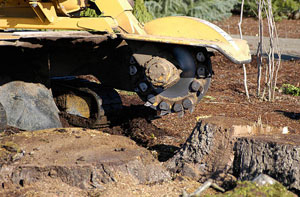
If you wish to get stump grinding done on your property, it is wise to hire the services of a tree surgery company with the proper gear and knowhow. The finest Fort William tree surgeons will understand that every last piece of the tree stump must be taken out to a depth of at least twelve inches. Having access to the proper stump grinding machinery means that the tree surgeon will have the ability to grind roots and stumps within a few millimetres of structures and walls while avoiding damage. This tailor-made stump grinding equipment is so flexible that it can even clear away tree stumps that are located in alleys, passageways and similarly inaccessible spots. It can take a herculean effort to get rid of the stumps of big trees, where the stump and main roots grow down to a significant depth, making the job even more challenging if you do not have the proper gear.
Tree Preservation Orders Fort William
Before you do any serious work on your trees in Fort William, you need to make sure that there is not a TPO (Tree Preservation Order) on any of them. You local authority is the place to head to find out if there are Tree Preservation Orders on any of your property's trees. You cannot undertake lopping, topping, felling, removal, wilful destruction, uprooting or wilful damage, without consent in writing from your local authority, if a tree on your property in Fort William is subject to a TPO. You can ask your tree surgeon to help with these checks, any reputable one will be glad to offer guidance and advice, or even do this on your behalf.
Also, if you plan to perform any work on a tree with a stem diameter of seventy five millimetres or more (1.5 metres from the ground), and your house is within a conservation area in Fort William, you must give your local planning authority a minimum of 6 wks written notice of the work.
Air-Spading Fort William
There are numerous problems that could make the health of your trees a concern, however issues with the root system are quite often the cause. A certified Fort William tree surgeon may need to access your tree's root system, so as to check for problems such as soil compaction and root rot.
Because of the potential for root damage in the digging down process, this was difficult to do previously. To successfully break up and strip away compacted soil without damaging tree roots or utilities, a contemporary technique that's often used by tree surgeons is "air spading".
Sometimes, foot traffic, construction work or passing vehicles can cause the soil surrounding a tree's roots to become compacted, and this is known to have a negative impact on its health. A tree can become "stressed" due to a lack of water and nutrients, which renders it more susceptible to attack by pests, disease and insects. Root flare problems can also be an issue, where the flare at the base of the trunk gets covered in an excess of soil, causing it's tissues to break down, and heightening the likelihood of root rot. Air-spading is a helpful technique for correcting this.
By forcing air into voids in the soil at speeds of up to twelve hundred miles per hour by means of an air compressor and an air-spading tool, the air-spading process swiftly breaks down the soil without affecting the tree roots. Soil is forced away from the tree's roots by the powerful flow of air, allowing immediate inspection and investigation. A looser layer of chip mulch and fertiliser can then be introduced to revive the tree, and a resolution implemented for any issues.
Emergency Call-Outs Fort William
Making an emergency call to a tree surgeon isn't an occurrence that's likely to happen all that often, however if you've got sizeable trees growing in your garden in Fort William, this could be a necessity at some time. When the conditions in Fort William are stormy and windy, local tree surgeons typically expect to see an increase in emergency call outs, and luckily many of them offer a 24/7 service for this very reason. The chances of damage or injury is greater when the weather is stormy, with branches breaking off and falling to the ground, and sometimes even whole trees toppling over. When tree limbs and branches start falling damaged fences, smashed greenhouses, busted garden furniture and splintered sheds are a common result, so avoidance is better than having to handle the consequences.
Naturally, the local authorities in the Fort William area will also often need to call on emergency tree surgery services, when large tree branches crash onto roads, railway lines and public pavements.
Even after the emergency work has been done, a tree that's lost some large limbs may have to be "re-balanced", and this could be carried out for aesthetic reasons or because the tree now looks lopsided, with more weight on one side than the other, perhaps resulting in additional problems. If you've got any of these tree related problems, you shouldn't attempt to sort any of them out by yourself, and you must immediately get in touch with a local Fort William tree surgeon who provides emergency tree care services, so that they can advise on the preferred course of action.
Dead-Wooding Fort William
All professional Fort William tree surgeons will undertake the process of dead-wooding, which is an essential element of tree management and care. Involving the careful removal or dead and rotting branches which could pose a hazard to vehicles, pedestrians or property, dead-wooding can make a tree both safer and healthier. There may be a number of different explanations why a tree's branches die, the most typical being diseases, attack by pests, root damage or heavy shading.
Although the usual rationale for the removal of dead branches is that of safety, it is also done to benefit the tree, or for aesthetic reasons. Disease and insect infestation can be attracted by an excess of dying, dead and damaged branches, therefore the tree's health can be radically improved by removing those dead branches. You can also improve a tree's appearance through this procedure, as trees with a lot of dead wood can also look rather ugly.
In most instances only larger dead branches will be cut out, because smaller ones pose little risk. On the other hand, any dead timber that's over 50mm in diameter might have to be removed in locations where a tree overhangs a public area, a dwelling, a highway, a garden or a park in Fort William.
Coming Soon: Tree pruning Fort William.
Tree Surgery Tasks Fort William

Fort William tree surgeons will likely help you with tree planting, tree fertilising, tree planning, tree removal Fort William, tree care services, landscape clearing, tree reduction in Fort William, stump grinding, tree pruning, woodchipping Fort William, decompaction, crown raising, drop crotching, woodland management, pollarding, tree lopping, tree dismantling in Fort William, root removal, hazard assessments in Fort William, tree work, tree felling, tree reshaping in Fort William, tree watering, forestry management Fort William, root flare exposure, crown cleaning, tree staking, landscaping, tree cutting, tree waste removal Fort William, damage restoration, retrenchment pruning Fort William, damaged tree removal Fort William, tree bracing, arboriculture and other tree surgeon services in Fort William, Scotland. Listed are just a small portion of the duties that are conducted by a local tree surgeon. Fort William companies will keep you informed about their full range of services.
Leaving a Review
Reviews and feedback are the driving force for any business in Fort William, and a great online review or testimonial can be the difference between a prospective customer using a company, or moving on to somewhere else. If someone you have employed has done a fantastic job, let others know how they did, by leaving them a nice review and sharing your experience. Letting other know about your personal experience will be beneficial to any potential client and also to the business itself. You should think back to how studying reviews helped you when you were trying to find somebody to do your work. Even when you considered a company with an impressive looking website, you may well have looked elsewhere if these promising signs weren't affirmed by some positive reviews.

However, when reviews are plainly displayed on a tree surgeon's website, can you really trust that they are genuine? Did real customers write these glowing reviews or did a member of the company, looking to promote their services, cook them up?
For genuine and honest reviews on any company in Fort William, the reviews on Google My Business listings is a good place to begin. This is the review website that is trusted by millions of people to determine company reputations, and affects their placement in the search engines too. After Google My Business reviews, the next biggest location for leaving local company reviews is Microsoft's alternative - Bing Places for Business. You will be able to help to boost the profile of a company that successfully worked on your tree surgery project by writing and submitting a glowing review on one of these websites, and while doing so establish an overall picture of the trustworthiness and working standards which they provided. Company reviews could also be left on Twitter and Facebook, which are excellent places leaving testimonials. The media marketing activities of any small business in Fort William will depend heavily on these social media platforms. Your favourable reviews will help to reinforce their message, and if you have offered recommendations to friends and relatives who are looking for similar services, this will give them a kick off point for their search for the perfect tree surgeon.
Going 'old school' and traditional is naturally still acceptable, and you can prepare a hand-written thank you letter and post or hand it in to the company. Believe it or not these are still vital in an internet crazy world and can be photographed for use on company websites, or maybe even framed or gathered together to form a review portfolio for one on one meetings with potential customers. It truly is an amazing feeling to think that you might have helped a small local business, no matter how your review was created.
Recent Tree Surgery Requests
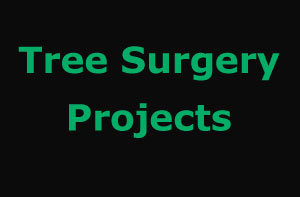
Hendrix Tanner was trying to find local tree surgeons near Cullen. Mr Reuben Cove from Milnathort needs to find someone who is prepared to do the pollarding of some trees along a pathway. Mr and Mrs Jarvis are looking for someone who can do some hedge cutting and shrub trimming in their garden in High Valleyfield. Miss Eva-Rose Toland from Linlithgow, Scotland needs to hire somebody who's prepared to carry out a bit of after winter hedge and tree pruning. Ms Laila Milne was looking to get a quotation from a tree surgeon in Aberfeldy who can chop down approximately 7 conifers of 150 - 200mm diameters in the garden of her detached home. Mr and Mrs Stephens are searching for a tree specialist who will cut back a horse chestnut tree that has grown over into a neighbours gardenin their home in Kennoway. Nola Kirk from Wemyss Bay, Scotland asked the question "is there a decent tree surgeon near me?". Declan Tennant was looking to get a quote from a tree surgeon in Salsburgh to remove a really large tree ASAP, in the garden his semi-detached property.
Obtaining Help and Assistance
When you are checking out local Fort William tree surgeons and arborists, you ought to ask them questions like: Are you able to produce references from former clients? Does your work adhere to the British Standard (BS3998)? Have you got public liability and employment insurance? Are you joined to a trusted professional association (i.e. The International Society of Arboriculture or the Arboricultural Association)? Will you provide me with an estimate in writing? Do you and your team have the correct qualifications and certificates (for chainsaw use and tree care)? to make certain they know exactly what they're up to and that they'll not inflict irreparable damage on your gorgeous trees. You really should think twice about hiring a tree surgeon if you do not receive satisfactory replies to any or all of those questions.

You can check out a directory of approved tree surgeons in Great Britain on the Arboricultural Association site, and also a lot of useful details regarding things to look for in a decent tree surgeon. The ISA (International Society of Arboriculture) is another fantastic resource which boasts a "find an arborist (tree surgeon)" tool (here) and a "verify tree surgeon's credentials" tool. You are also able to find lots of information about tree surgery as a profession by going to the Wikipedia "Arborist" page here. A Government approved organisation where you can also locate trusted tradesmen including tree surgeons, comes in the form of Trustmark. Trustmark looks at quality customer service, good trading practices and technical proficiency providing a level playing field of quality and assurance.
Tree Surgeons Near Fort William: Also find: Banavie tree surgeons, Lochyside tree surgeons, Glencoe tree surgeons, Caol tree surgeons, Mallaig tree surgeons, Fort Augustus tree surgeons, Onich tree surgeons, Corpach tree surgeons, Inverlochy tree surgeons, Killin tree surgeons, Torlundy tree surgeons, Druimarbin tree surgeons, Kinlochleven tree surgeons, Spean Bridge here. Most of these places are serviced by an experienced tree surgeon. Fort William residents can get tree surgery quotes by going here.
Tree Care Services Fort William
- Fort William Tree Transplanting
- Fort William Tree Dismantling
- Fort William Air-Spading
- Fort William Crown Raising
- Fort William Stump Grinding
- Fort William Tree Cutting
- Fort William Eco-Plugging
- Fort William Tree Felling
- Fort William Woodland Clearance
- Fort William Tree Pollarding
- Fort William Tree Watering
- Fort William Crown Removal
- Fort William Tree Surveys
- Fort William Tree Bracing
Tree Surgeons Around Fort William: Tree surgeons were recently doing work in the following Fort William locations: Lochaber Road, Bank Street, Blarmacfoldach, Wallace Place, Station Square, Corrievullin, Caithness Place, Argyll Road, Cameron Square, Telford Place, Coire Leis, Benlochy 76 Camaghael, Ross Place, Selkirk Place, Campbell Court, Banff Crescent, Garvan, Duisky, Kinross Place, Peebles Place, Middle Street, Glen Nevis Business Park, Lothian Place, Carn Dearg Road, Braemore Place, Monzie Square, Taigh A Ghlinne, a Garvan, and in households in these postcodes: PH33 6EA, PH33 6QL, PH33 6LH, PH33 6JS, PH33 6QH, PH33 6LP, PH33 6EE, PH33 6BJ, PH33 6DP, PH33 6QJ. Work was executed in these places by a certified tree surgeon. Fort William home and property owners were given trusted and dependable tree surgery services on every occasion.
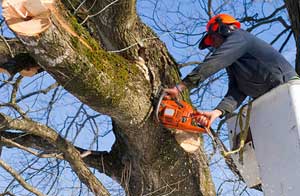 Tree Surgeon Fort William
Tree Surgeon Fort William Tree Care Fort William
Tree Care Fort William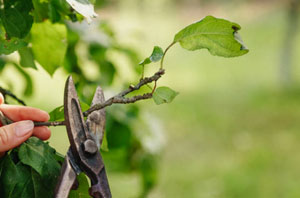 Tree Surgery Fort William
Tree Surgery Fort WilliamTo obtain local info relating to Fort William, Scotland check here
More Scotland Tree Surgeons: Scotland tree surgeons: Barrhead, Kinross, Newton Mearns, Uddingston, Edinburgh, Tayport, Forfar, East Kilbride, Fort William, Prestwick, Arbroath, Ellon, Jedburgh, St Andrews, Broxburn, Lerwick, Dalry, Dalkeith, Kirriemuir, Fraserburgh, Johnstone, Kilwinning, Armadale, Viewpark, Stenhousemuir, Stonehaven, Brechin, Peterhead, Cowdenbeath, Airdrie, Lenzie, Clydebank, Kirkintilloch, Methil, Rutherglen, Hawick, Stornoway, Milngavie, Ayr, Stepps, Erskine, Strathaven, Dunbar, Dumbarton, Burntisland, Stranraer, Falkirk, Paisley, Hamilton, Carnoustie, Coatbridge, Nairn, Leven, Inverurie, Irvine, Aberdeen, Motherwell, Bearsden, Musselburgh, Penicuik, Renfrew, Ballingry, Cambuslang, Ardrossan, Westhill, Kilsyth, Lanark, Larbert, Kilmarnock, Inverkeithing, Dunblane, Elgin, Whitburn, Tullibody, Dalgety Bay, Forres, Galashiels, Tranent, Bonnyrigg, Stirling, Carluke, Bathgate, Newport-on-Tay, Rosyth, Greenock, Linlithgow, Peebles, Girvan, Dunfermline, Kelso, Blantyre, Livingston, Bonnybridge, Stevenston, Stewarton, Lochgelly, Cupar, Linwood, Prestonpans, Buckhaven, Inverness, Montrose, Alloa, Grangemouth, Ardeer, Troon, Perth, Kirkcaldy, Cumnock, Bishopbriggs, Dingwall, Dundee, Galston, Cumbernauld, Wishaw, Glenrothes, Dumfries, Largs, Larkhall, Glasgow, Denny, Bishopton, Bellshill and Alva.
Tree Surgery PH33 area, telephone code 01397.
TOP - Tree Surgeon Fort William
More Trades: Gate Fitters - Gutter Cleaning - Tilers - Carpet Fitters - Carpenters
Tree Management Fort William - Arboriculturalist Fort William - Tree Surgeon Fort William - Stump Grinding Fort William - Tree Removal Fort William - Tree Care Fort William - Vegetation Control Fort William - Tree Surgeon Near Me - Tree Surgery Fort William





